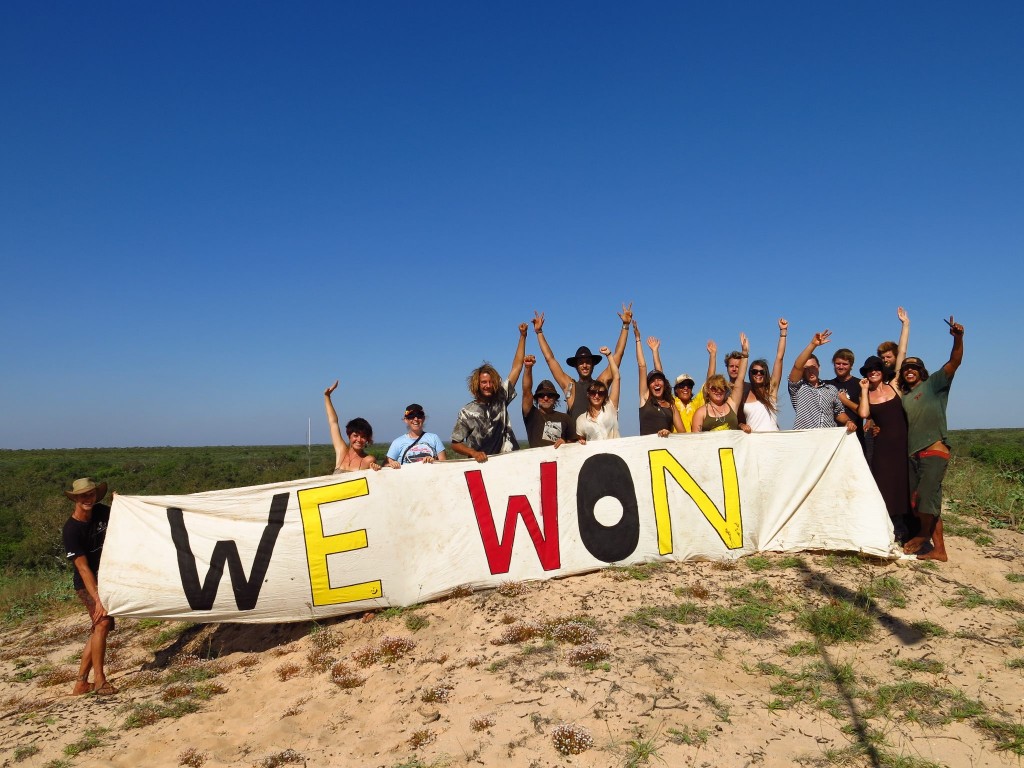This was posted in 2016 in an attempt to provide a launch point for discussion when climate focussed civil disobedience was only moving somewhat mainstream in 2014-16. We haven’t made anywhere near the modest progress I dreamed of as I look back in 2024… but its useful reflection.
~
There are many conversations happening in the climate movement at the moment – with increasingly dire news – and likely breaching 2 degrees of warming or more by 2050, and the Paris agreement supposedly coming into effect – we are seeing no signals from government they are taking this seriously – instead we have the Labor Party in Queensland invoking special powers, and favours to hasten the Adani coal mega mines. Ongoing conversations have been given new momentum by the thinking outlined in “This is an Uprising“ which has generated lively debate and meetings around the country.
One of the challenges we have is a lack of imagination of what the future might look like. It is hard to think through what a healthy future and a powerful resistance movement might look like to get us there when we are constrained by consistent bad news.
So we had a go at this… as part of a larger document and some thinking around climate and growing powerful nonviolent resistance to fossil fuels. It is not intended to be a blue print or the be all and end all… but just a conversation starter…
Let us know what your version of a powerful resistance movement looks like? And how do we get there? Whilst the damage will still keep unfolding even if we cease fossil fuels tomorrow- what could it look like if we won?
VISION
It’s the year 2022. We have passed 1.5 degrees, and for the fourth year in a row the east coast has been battered by a one in one hundred year’s storm. Fires have destroyed towns near Adelaide and the South West of Australia. Victoria has been bruised by another huge fire, close to those of Black Saturday some ten years back, and people are moving away rather than rebuilding. Pacific Islands are relocating, new species are being lost every day, and the rapidly changing climate has led to the re-emergence of diseases killing thousands.
A fractured senate, scandals and defections had turned the government back to an early election in 2017 but the progressive movement was caught on the back foot, and unable to marshal the response required. Right wing scare-mongering helped the Liberals secure a small majority.
In early 2021 an ALP government was elected in what was broadly defined as the “climate election”. Its ten years too late but their strong policy on climate change was supported by the electorate with polling determining the single biggest issue for voters was climate change. Large scale spending on wind, solar thermal and job announcements were rolled out to hugely positive response. The significant shift in public sentiment was broadly attributed to organising, and mobilising in the several years prior to the election, as opposed to during the formal campaign.
The Climate Justice Project was highly visible during the election campaign and in the two years leading up to it. The political organising sector was involved in a marginal electorate campaign credited with getting the last climate deniers out of parliament in conjunction with environment organisations, unions and GetUp. Two high profile launches of large scale community energy projects were launched in the La Trobe and Hunter Valley, and a solar project up in economically depressed Central Queensland, working with mob who had previously fought back against coal projects in the region.
In the year leading up to the 2022 election the Climate Justice Project (CJP) was instrumental in leading city occupations that shut down capital cities to send a clear message that business as usual is no longer an option. They have tens of 1000’s of active members, and organising collectives in every capital city as well as teams that have specifically relocated to support regional areas to work with communities that are transitioning away from fossil fuels. CJP is a grassroots movement. Although some infrastructure and organising is resourced by NGO’s they remain independent, and use large scale consensus decision making, sophisticated collaborative digital tools, and small affinity group structures that work together to build larger actions.
Over 2019-21 CJP mutual aid teams mobilised to the site of bushfires and impact sites of extreme weather. Nonviolent peacekeeping teams of the Climate Justice Force were credited with deterring looting as they deployed in towns, sharing critical resources and supporting the local communities. The yellow nomad’s elders of CJP, along with knitting nana’s, also move out to feed and care for communities.
The Adani coal mine, and Shenhua were abandoned respectively in 2017 & 2018. Whilst Adani finally cited market uncertainty and backed away after slowly stepping back, the Shenhua project was bought out, and pushed ahead with new ownership. They were met with a wave of resistance that had previously been rivalled only by the numbers of the Bentley Blockade. 1000’s of people participated in mass blockades and strategic stop work actions. No new coal has been built, or proposed in three years, and the movement for just transitions is in full swing across the country.
Over 2018-2020 a series of rapid response actions rolled out in the cities in response to climate fueled extreme weather. Within days of major events thousands of people hit the streets, MP’s offices and fossil fuel companies. In one instance a state parliament who had voted down ambitious renewable energy targets was occupied and surrounded by 15000 people. They were joined by staff inside, as well as government workers in many departments who refused to cooperate in implementing damaging projects.
CJP don’t wear uniforms or logos, but a yellow colour is broadly identified with their work. They are trained in nonviolent strategy, highly disciplined and prioritise the voices of those most impacted, resource and amplify them. Class and race analysis is encouraged and anti-oppression training is mandatory. They have positive collaborative working relationships with Indigenous mob, Islanders and frontline coal communities, but these groups also caucus and operate as autonomous collectives on issues they determine, and run their own actions in collaboration with other first nations organisations. They encourage a culture of leadership, not leaders, and are transparent about spokespeople and those seen to speak for the movement. They are adept at strategy, have long range campaign goals but are nimble on the ground.
They have undergone specialised skills training that has been conducted in conjunction with the CFA, international aid workers deployed to disaster zones, street medics, psychologists and community safety teams (trained in peacekeeping and nonviolent accompaniment work), and legal teams. The knitting nanas enjoy working with new generations of young people, and 1000’s of older retired Australians have taken “the Nomad Pledge – a climate retirement” … mobilising their caravans, resources and energy to the last few sites of proposed new fossil fuel projects in the country, as well as coal mines that are being pressured to close. A sea of yellow descends on bruised communities who feel abandoned by governments whose budgets are straining to pay for the response of ever increasing extreme weather events. They proudly wear photos of their grandchildren on their shirts and are invigorated in their retirement.
As well as working in regional and rural areas the CJP also organise in the cities. Large scale organising work was done in low income areas, in the outer suburbs of the capital cities. Climate community safety teams are deployed in heat waves, working to support vulnerable residents in city heat islands and organising has been done with working class residents in housing estates and the fringing suburbs of capital cities.
Climate safety and economic justice have been interwoven into narratives about climate change. Large scale community organising efforts in conjunction with unions identified accessible housing, affordable energy, healthcare and more robust community networks as key to building community resilience across demographics, and neighbourhood councils are working on local projects that prioritise these. Alternative economies are springing up in housing estates and across the country.
There have been large scale disruptive climate demonstrations of 130 000 people in Melbourne, 80 000 in Sydney, and 1000s mobilised to unconventional gas sites. Several large NGO’s also participated, shared pledges of civil disobedience and mobilised large sectors of their membership. Fossil fuel companies are finding it difficult to maintain rental city locations and a number have been required to move out of the city into unlabeled offices in industrial parks. Consistently disruptive demonstrations have made them unpopular with other tenants, and they are losing staff, as decreasing wages linked to the rapid down turn in the minerals boom aren’t able to offset the social pariah status of working for what is now described as toxic industries. As the industry fractures, senior level industry whistleblowers have come forward, further tarnishing the image of fossil fuels with stories of bullying,
unsafe workplace conditions, and vicious attacks on farmers and regional communities. The industry is in chaos.
Community campaigns to “take the power back” have harnessed anti-government sentiment, and encouraged not only huge increases in private solar installation, but also significant amounts of small scale community renewables. Work over several years talking of economic and climate justice as interwoven issues has re-booted student involvement in politics. Student activists have overtaken their universities, and divestment continues to have large scale impact. 300 local councils have pledged to be “Fossil Free Towns”, divested and ceased sponsorship relationships with mining companies. Several European nations have divested. Unions are talking a general strike. Coal mines are closing, and communities transitioning.
Activism is not a dirty word.
***
If you want to join the fossil free resistance and be connected to action in your area, check local groups..
An important note: there will be no climate peace, without justice. A treaty/treaties, and concrete policy outcomes that acknowledge sovereignty and a history of genocide in this country and seek to properly address the dispossession and long lived effects of colonisation are critical in any vision for a just future. Unfortunately the mob we know working in the area have not had capacity to input into this document as yet. They are busy working on their own priorities. Their input will be welcomed when they have time. The writer didn’t feel it was appropriate to speak for Aboriginal people in this regard and so this aspect was left out of the piece.


wow !! – bit more about economic relocalisation as a coherent alternative economic arrangement would also round out this piece – and really provide folk with the economic vision that people can’t really see – see Local Futures.org and Local Lives Global Matters Conference eg. starting with local food is pretty good
well done good on you !
It was hard to include everything in detail – why don’t you give us a couple of paragraphs that sum up your thoughts? We’d love to hear what other people think should be in there.